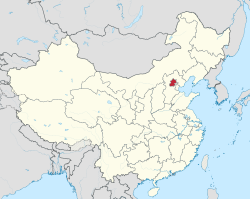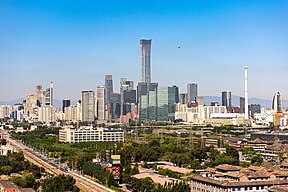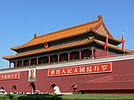Beijing
北京 Peking | |
|---|---|
| Beijing Municipality[2] | |
 | |
 Location of Beijing Municipality within China | |
| Coordinates (Tian'anmen Square national flag): 39°54′24″N 116°23′51″E / 39.90667°N 116.39750°E | |
| Country | China |
| Established | 1045 BC |
| Founded by | Zhou dynasty (Western Zhou) |
| Municipal seat | Tongzhou District |
| Divisions - County-level - Township- level | 16 districts 343 towns and subdistricts |
| Government | |
| • Type | Municipality |
| • Body | Beijing Municipal People's Congress |
| • Party Secretary | Yin Li |
| • Congress Chairman | Li Xiuling |
| • Mayor | Yin Yong |
| • CPPCC Chairman | Wei Xiaodong |
| • National People's Congress Representation | 53 deputies |
| Area | |
• Municipality | 16,410.54 km2 (6,336.14 sq mi) |
| • Land | 16,410.54 km2 (6,336.14 sq mi) |
| • Urban | 16,410.54 km2 (6,336.14 sq mi) |
| • Metro | 12,796.5 km2 (4,940.8 sq mi) |
| Elevation | 43.5 m (142.7 ft) |
| Highest elevation | 2,303 m (7,556 ft) |
| Population (2020 census)[4] | |
• Municipality | 21,893,095 |
| • Density | 1,300/km2 (3,500/sq mi) |
| • Urban | 21,893,095 |
| • Urban density | 1,300/km2 (3,500/sq mi) |
| • Metro | 22,366,547 |
| • Metro density | 1,700/km2 (4,500/sq mi) |
| • Ranks in China | Population: 27th; Density: 4th |
| Major ethnic groups | |
| • Han | 95% |
| GDP (2023)[5] | |
| • Municipality | CN¥ 4,376 billion (13th)
US$ 621 billion |
| • Per capita | CN¥ 200,273 (1st)
US$ 28,421 |
| Time zone | UTC+08:00 (CST) |
| • Summer (DST) | UTC+09:00 (CDT) |
| Postal codes | 100000–102629 |
| Area code | 10 |
| ISO 3166 code | CN-BJ |
| Growth [clarification needed] | |
| License plate prefixes | 京A, C, E, F, G, H, J, K, L, M, N, P, Q 京B (taxis) 京G, Y (outside urban area) 京O, D (police and authorities) |
| Abbreviation |
|
| HDI (2022) | 0.905[6] (1st) – very high |
| Website | beijing.gov.cn english |
| Symbols | |
| Flower | China rose (Rosa chinensis) Chrysanthemum (Chrysanthemum morifolium) |
| Tree | Chinese arborvitae (Platycladus orientalis) Pagoda tree (Styphnolobium japonicum) |
| Beijing | |||||||||||||||||||||||||||||||||||||||||||
|---|---|---|---|---|---|---|---|---|---|---|---|---|---|---|---|---|---|---|---|---|---|---|---|---|---|---|---|---|---|---|---|---|---|---|---|---|---|---|---|---|---|---|---|
 "Beijing" in regular Chinese characters | |||||||||||||||||||||||||||||||||||||||||||
| Chinese | 北京 | ||||||||||||||||||||||||||||||||||||||||||
| Hanyu Pinyin | Běijīng | ||||||||||||||||||||||||||||||||||||||||||
| Postal | Peking[note 1] Peiping (1368–1403; 1928–1937; 1945–1949) | ||||||||||||||||||||||||||||||||||||||||||
| Literal meaning | "Northern Capital" | ||||||||||||||||||||||||||||||||||||||||||
| |||||||||||||||||||||||||||||||||||||||||||
Beijing,[a] previously romanized as Peking,[b] is the capital city of China. With more than 22 million residents,[11] it is the world's most populous national capital city as well as China's second largest city after Shanghai.[12] It is located in Northern China, and is governed as a municipality under the direct administration of the State Council with 16 urban, suburban, and rural districts.[13] Beijing is mostly surrounded by Hebei Province and neighbors Tianjin to the southeast; together, the three divisions form the Jing-Jin-Ji cluster.[14] It is ranked as the 10th most important city in the world by Knight Frank.[15]
Beijing is a global city and one of the world's leading centres for culture, diplomacy, politics, finance, business and economics, education, research, language, tourism, media, sport, science and technology and transportation and art. It is home to the headquarters of most of China's largest state-owned companies and houses the largest number of Fortune Global 500 companies in the world, as well as the world's four biggest financial institutions by total assets.[16] It is also a major hub for the national highway, expressway, railway, and high-speed rail networks. For a decade before the COVID-19 pandemic, the Beijing Capital International Airport was Asia's busiest airport (2009–2019) and the second busiest airport in the world (2010–2019).[17] In 2020, the Beijing subway was the fourth busiest and second longest in the world.[18] The Beijing Daxing International Airport, Beijing's second international airport, is the largest single-structure airport terminal in the world.[19][20] The city has hosted numerous international and national sporting events, the most notable being the 2008 Summer Olympics and 2008 Summer Paralympics Games. In 2022, Beijing became the first city ever to host both the Summer and Winter Olympics,[21] and also the Summer and Winter Paralympics.[22]
Beijing combines both modern and traditional style architectures, with one side of the city being modernized and renovated to fit the times, and the other half still offering traditional hutong districts.[23] Beijing is one of the oldest cities in the world, with a rich history dating back over three millennia. As the last of the Four Great Ancient Capitals of China, Beijing has been the political center of the country for most of the past eight centuries,[24] and was the largest city in the world by population for much of the second millennium CE.[25] With mountains surrounding the inland city on three sides, in addition to the old inner and outer city walls, Beijing was strategically poised and developed to be the residence of the emperor and thus was the perfect location for the imperial capital. The city is renowned for its opulent palaces, temples, parks, gardens, tombs, walls and gates.[26] Beijing is one of the most important tourist destinations in the world. In 2018, Beijing was the second highest earning tourist city in the world after Shanghai.[27] Beijing is home to many national monuments and museums and has eight UNESCO World Heritage Sites—the Forbidden City, Temple of Heaven, Summer Palace, Ming Tombs, Zhoukoudian Peking Man Site, Beijing Central Axis and parts of the Great Wall and the Grand Canal—all of which are popular tourist locations.[28] Siheyuans, the city's traditional housing style, and hutongs, the narrow alleys between siheyuans, are major tourist attractions and are common in urban Beijing.
Beijing's public universities make up more than one-fifth of Double First-Class Construction universities, and many of them consistently rank among the best in the Asia-Pacific and the world.[29][30][31] Beijing is home to universities, including Tsinghua University and Peking University.[32][33][34] Beijing CBD is a center for Beijing's economic expansion, with the ongoing or recently completed construction of multiple skyscrapers. Beijing's Zhongguancun area is a world leading center of scientific and technological innovation as well as entrepreneurship. Beijing has been ranked the city with the largest scientific research output by the Nature Index since the list's inception in 2016.[35][36] Beijing hosts 175 foreign embassies as well as the headquarters of many organizations, including the Asian Infrastructure Investment Bank (AIIB), the Shanghai Cooperation Organisation (SCO), the Silk Road Fund, the Chinese Academy of Sciences, the Chinese Academy of Engineering, the Chinese Academy of Social Sciences, the Central Academy of Fine Arts, the Central Academy of Drama, the Central Conservatory of Music, and the Red Cross Society of China.
- ^ "Beijing Info". The People's Government of Beijing Municipality. Archived from the original on 7 August 2024. Retrieved 3 July 2024.
- ^ "Government". The People's Government of Beijing Municipality. Archived from the original on 29 July 2024. Retrieved 3 July 2024.
- ^ "Doing Business in China – Survey". Ministry of Commerce of the People's Republic of China. Archived from the original on 26 May 2014. Retrieved 5 August 2013.
- ^ "Communiqué of the Seventh National Population Census (No. 3)". National Bureau of Statistics of China. 11 May 2021. Archived from the original on 11 May 2021. Retrieved 11 May 2021.
- ^ "National Data". China NBS. March 2024. Archived from the original on 9 January 2020. Retrieved 22 June 2024. see also "National Data". China NBS. March 2024. Archived from the original on 9 January 2020. Retrieved 22 June 2024.; see also "zh: 2023年北京市国民经济和社会发展统计公报". beijing.gov.cn. 21 March 2024. Archived from the original on 3 October 2024. Retrieved 12 June 2024. The average exchange rate of 2023 was CNY 7.0467 to 1 USD dollar "Statistical communiqué of the People's Republic of China on the 2023 national economic and social development" (Press release). China NBS. 29 February 2024. Archived from the original on 5 March 2024. Retrieved 22 June 2024.
- ^ "Human Development Indices (8.0)- China". Global Data Lab. Archived from the original on 24 September 2024. Retrieved 23 September 2024.
- ^ "Beijing". Lexico UK English Dictionary. Oxford University Press. Archived from the original on 25 October 2020.
- ^ Wells, John (3 April 2008). Longman Pronunciation Dictionary (3rd ed.). Pearson Longman. ISBN 978-1-4058-8118-0.
- ^ China Postal Album: Showing the Postal Establishments and Postal Routes in Each Province (1st ed.). Shanghai, China: Directorate General of Posts. 1907.
- ^ "Peking". Oxford English Dictionary (Online ed.). Oxford University Press. (Subscription or participating institution membership required.)
- ^ "中经数据". wap.ceidata.cei.cn. Archived from the original on 13 March 2024. Retrieved 13 March 2024.
- ^ "China: Provinces and Major Cities – Population Statistics, Maps, Charts, Weather and Web Information". City Population. Archived from the original on 11 February 2019. Retrieved 15 August 2023.
- ^ Figures based on 2006 statistics published in 2007 National Statistical Yearbook of China and available online at 2006年中国乡村人口数 中国人口与发展研究中心 (archive). Retrieved 21 April 2009.
- ^ "Basic Information". Beijing Municipal Bureau of Statistics. Archived from the original on 13 March 2012. Retrieved 9 February 2008.
- ^ "Knight Frank: City Wealth Index". Archived from the original on 20 June 2023. Retrieved 20 June 2023.
- ^ "Top 100 Banks in the World". relbanks.com. Archived from the original on 29 July 2018. Retrieved 12 September 2018.
- ^ "Year to date Passenger Traffic". Airports Council International. 23 June 2014. Archived from the original on 29 January 2017. Retrieved 26 June 2014.
- ^ UITP Secretariat (May 2022). "WORLD METRO FIGURES 2021" (PDF). UITP. Archived from the original (PDF) on 9 November 2023. Retrieved 14 December 2023.
- ^ "What does the world's largest single-building airport terminal look like?". BBC News. 15 April 2019. Archived from the original on 18 April 2019. Retrieved 20 April 2019.
- ^ Taylor, Alan. "Photos: The World's Largest Airport-Terminal Building – The Atlantic". The Atlantic. Archived from the original on 25 September 2019. Retrieved 25 September 2019.
- ^ Cite error: The named reference
:2was invoked but never defined (see the help page). - ^ Cite error: The named reference
:3was invoked but never defined (see the help page). - ^ MorTraveling Team. "The Asian Cities You Should Spend Some Time In". MorTraveling. Archived from the original on 2 May 2024. Retrieved 2 May 2024.
- ^ "Peking (Beijing)". Encyclopædia Britannica. Vol. 25 (Macropædia, 15th ed.). p. 468.
- ^ "Top Ten Cities Through History". ThingsMadeUnthinkable.com. Archived from the original on 24 June 2011. Retrieved 28 November 2016.
- ^ "Beijing". World Book Encyclopedia. 2008. Archived from the original on 19 May 2008. Retrieved 7 August 2008.
- ^ Töre, Özgür (22 October 2018). "WTTC reveals the world's best performing tourism cities". ftnnews.com. Archived from the original on 7 August 2021. Retrieved 7 August 2021.
- ^ 走进北京七大世界文化遗产 – 千龙网. qianlong.com (in Simplified Chinese). 18 August 2014. Archived from the original on 29 November 2014. Retrieved 21 November 2014.
- ^ "US News Best Global Universities in Beijing". US News & World Report. 25 June 2024. Archived from the original on 6 November 2020. Retrieved 30 June 2024.
- ^ "World University Rankings 2024: China creeps closer to top 10". Times Higher Education (THE). 27 September 2023. Archived from the original on 8 October 2023. Retrieved 9 October 2023.
- ^ "ShanghaiRanking's Academic Ranking of World Universities". shanghairanking.com. Archived from the original on 15 August 2024. Retrieved 17 August 2024.
- ^ "World University Rankings". Times Higher Education (THE). 25 September 2023. Archived from the original on 28 September 2023. Retrieved 9 October 2023.
- ^ "Emerging Economies". Times Higher Education (THE). 22 January 2020. Archived from the original on 20 February 2020. Retrieved 13 September 2020.
- ^ "University Results | Rankings". research.unsw.edu.au. Archived from the original on 28 June 2023. Retrieved 17 August 2024.
- ^ Cite error: The named reference
:10was invoked but never defined (see the help page). - ^ jknotts (25 September 2020). "Beijing Defends its Title as World's Top City for Scientific Research". thebeijinger.com. Archived from the original on 27 September 2020. Retrieved 27 September 2020.
Cite error: There are <ref group=note> tags on this page, but the references will not show without a {{reflist|group=note}} template (see the help page).
Cite error: There are <ref group=lower-alpha> tags or {{efn}} templates on this page, but the references will not show without a {{reflist|group=lower-alpha}} template or {{notelist}} template (see the help page).





